We include products in articles we think are useful for our readers. If you buy products or services through links on our website, we may earn a small commission.
How to Intermittent Fast: 8+ Proven Intermittent Fasting Schedules
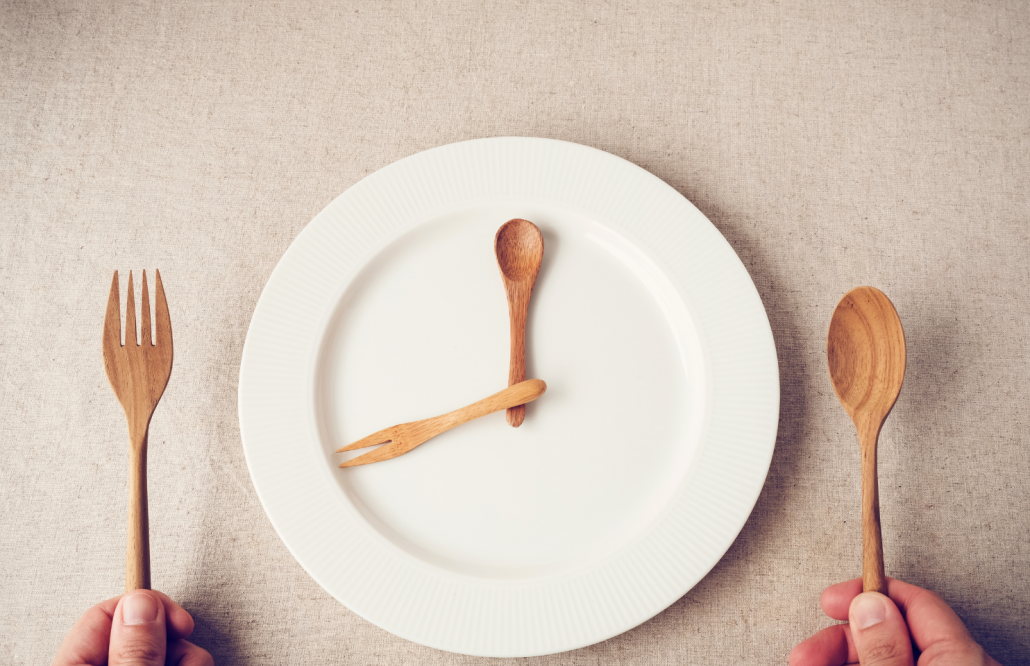
Table of Contents
- What is Intermittent Fasting?
- How To Do Intermittent Fasting
- How to Do The 12 Hour Intermittent Fasting Schedule
- The 16/8 Intermittent Fasting Plan
- How to Do The 20/4 Intermittent Fasting Plan
- OMAD Intermittent Fasting Schedule
- The Warrior Diet
- 5:2 Diet
- Circadian Rhythm Fasting
- Eat Stop Eat
- Alternate Day Fasting
- 36 hour fast
- Longer Fasts
- The Bottom Line
Intermittent fasting is one of the most popular diet trends on earth. People use intermittent fasting to improve their overall health, lose weight, and simplify their lives.
In addition to weight loss, many studies show that intermittent fasting can reduce inflammation while boosting brain function and overall physical performance .
Though intermittent fasting is certainly a trend, its effectiveness is linked to the role of fasting in human dietary evolution.
In this article, we’ll look closely at 8 of the most popular and proven intermittent fasting schedules.
Ancient Origins of Intermittent Fasting
Intermittent fasting is based on an ancestral eating pattern from a time when humans didn’t always have immediate access to food–most of human history up to a few thousand years ago.
According to a recent study on evolution and food availability, humans evolved in an environment when they feasted on large animals, then fasted between successful hunts.
We are biologically hardwired to survive and even thrive, for extended periods of time without eating.
Since our ancestors didn’t have clocks to set their fasting by, it makes sense that there are various successful ways to intermittent fast (or feast).
These different intermittent fasting methods styles of intermittent fasting work for different people based on their specific nutrient needs and metabolism. Here is a quick guide to help you decide which method works best for you.
What is Intermittent Fasting?
Intermittent fasting is an eating schedule that cycles between periods of eating and periods of fasting. Yet the definition of fasting is to abstain from all, or some types of food. This is why we also like to refer to it as “intermittent feasting”.
Though IF outlines when you should eat, IF does not define what you should eat.
ahttps://www.doctorkiltz.com/intermittent-fasting-keto/
What vs. When
Many recent discoveries about metabolism and hormone regulation support the notion that when you eat is equally as important as what you eat. A study on cell metabolism and timed eating concluded that timing has a direct effect on health and weight gain. The findings suggest that intermittent fasting is potentially a lifestyle that could curb the obesity epidemic. According to the study the focus needs to shift from what we eat, to when we eat it.
When you eat is equally, if not more important as what you eat.
Dr. Robert Kiltz
Why fast?
Intermittent fasting does more than burn fat and trigger weight loss. While some naturally think intermittent fasting is designed for weight loss that’s not the case. For most, weight loss isn’t the primary goal. They want to feel good and improve their overall health.
Studies have demonstrated how intermittent fasting and timing meals have been linked to improved physical performance; helping you lose fat without losing muscle mass and boosting endurance . The effects fasting has on metabolism offers improved brain function. People have reported feeling their memory became sharper and improvement to their focus and concentration. Intermittent fasting can also have a positive effect on heart health including lowering blood pressure and resting heart rate.
Lifestyle enhancement is another reason for intermittent fasting. Many advocates of intermittent fasting find it is easier to maintain healthy eating habits with this method. Fewer meals makes meal prep easier, less time spent in the kitchen/at the grocery store, and more time to focus on what really matters.
How To Do Intermittent Fasting
There are many methods of intermittent fasting and eating schedules people use to improve their health. Which one is right for you likely depends on your schedule/lifestyle, how much effort you want to put in, and the results you are looking for. As with anything else different methods work best for different people. Here we will outline the most common methods of intermittent fasting or if you prefer, intermittent feasting, and how to approach each one.
*Keep in mind that fasting doesn’t mean not drinking. Each method we discuss allows unlimited water and also coffee or tea without creamers or sweeteners during a fasting period.
How to Do The 12 Hour Intermittent Fasting Schedule
Most agree this method is the most common and has the simplest rules (though it may be less beneficial given the rather short fasting period) and many may already do this naturally. Much of the fasting time occurs during sleep. It also follows the natural rhythm of the average person’s day to day. Because of this, the 12 hour fast method may be easiest for beginners.
The Rules
Commit to eating only in a 12-hour window each day. Refrain from eating the other 12 hours of the day.
Example
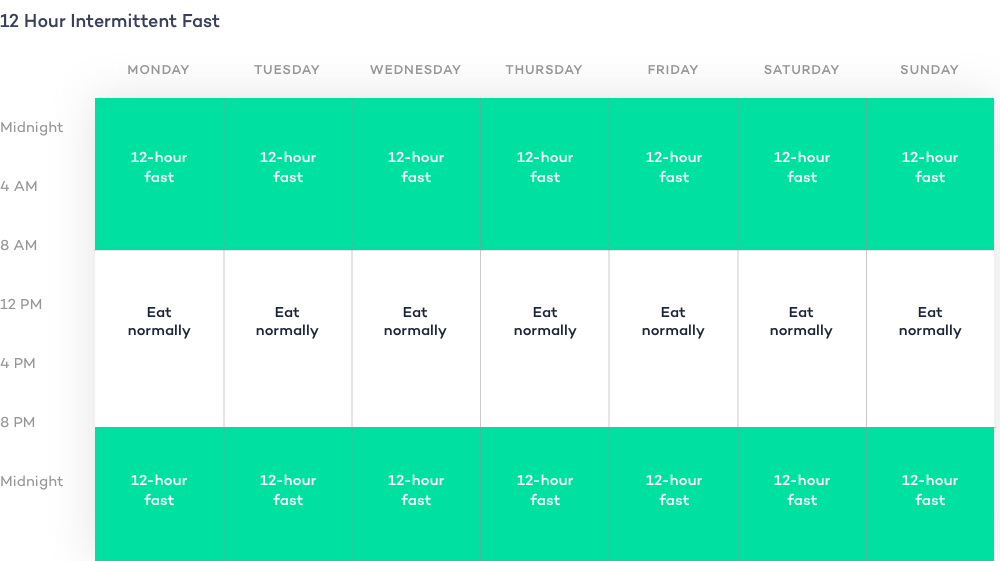
Eat all your meals between 8 a.m. and stop eating before 8 p.m. then wait for breakfast until 8 a.m. the following day. Really not much of a fast if you ask me. This is already the standard american meal timing (minus midnight snacking).
The 16/8 Intermittent Fasting Plan
This method is another straightforward version. Many people begin with the 12 hour fast and gradually find the 16/8 method. The 16/8 method is another beginner friendly method to intermittent fasting.
The Rules
This method calls for fasting for 16 hours and limiting your meals to an eight-hour eating window.
Example
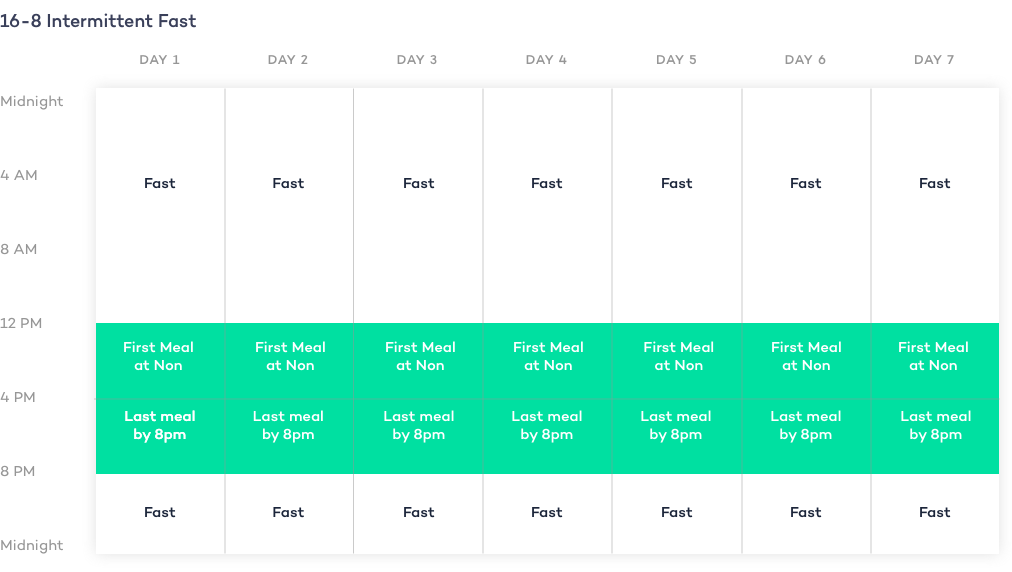
A person following this method would finish meals by 8 p.m. skip breakfast the next day and not eat again until lunch at noon.
Things to Note
The rules of this method differ slightly between men and women. Because some women are more sensitive to calorie restrictions and may experience hypothalamic and hormone disturbances, some experts recommend women limit themselves to a 14 hour fast. For this reason (and others) it is important to always check with a health care provider before beginning a longer intermittent fasting regimen. 1
How to Do The 20/4 Intermittent Fasting Plan
The 20:4 method of intermittent fasting is very close to the 16:8 method. The only differences are a longer fasting period and shorter eating window.
The Rules
Fast for 20 hours. Eat during a four hour window.
Example
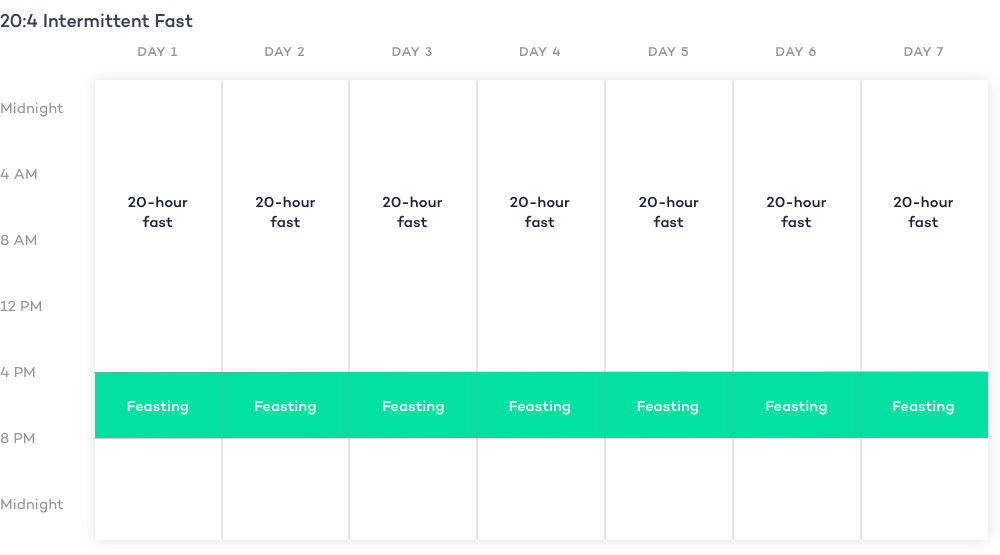
Eating between 4 pm and 8 pm and fasting the other 20 hours of the day. This eating window could be broken down into two regular-sized meals, or one snack and one larger meal.
OMAD Intermittent Fasting Schedule
Aka One Meal a Day. OMAD is a slightly more extreme version of the intermittent fasting regimens we have already discussed. This method you could truly call intermittent feasting.
The Rules
This method has the simplest rule, but perhaps one of the most intense. OMAD requires fasting for 23 hours. The eating window is the same one hour period each day.
Example
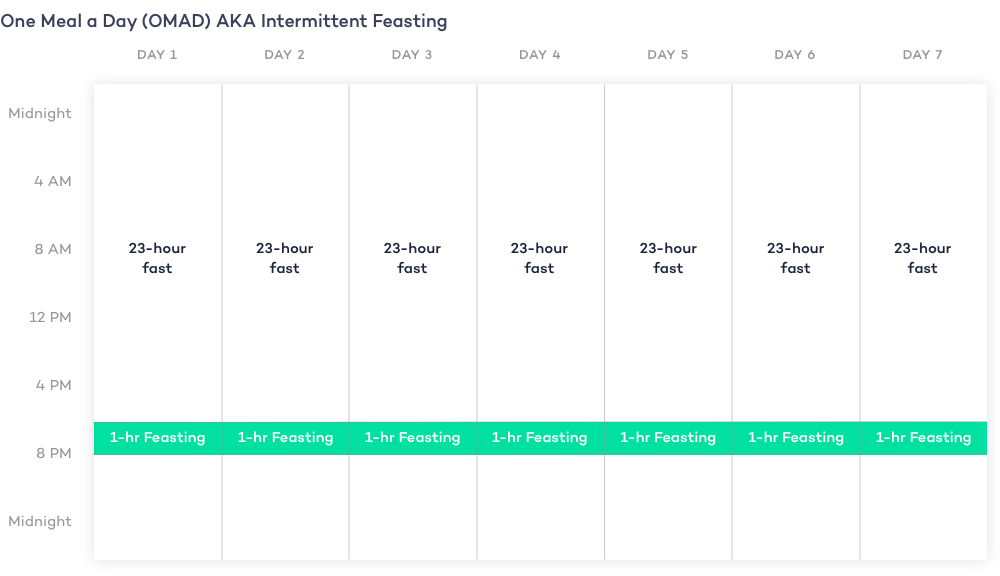
Fast from 8 p.m. to 7 p.m. the next day eat one large meal at 7 p.m. and finish eating by 8 p.m.
Things to note
If you are following an OMAD diet it is recommended to eat your meal right after your most active part of the day (typically the evening when you’re about to take a long rest and digest snooze). It’s important to remember you’re aiming to get all of your calories for an entire day within ONE meal. Most adults require a minimum of 1200 calories per day. 2 Getting enough calories is important for many reasons, including keeping your immune system healthy. 3
* This method is not for everyone. Children, the elderly, and people with certain health conditions should not use this method of fasting/eating without consulting a healthcare profesional.
The Warrior Diet
Another more extreme method of intermittent fasting, and this one sounds somewhat medieval:
According to its founder, Ori Hofmekler (Former Israeli Defense Special Forces) The Warrior Diet is based on the way ancient warriors ate; consuming little during the day and feasting in the evening. 4
The Rules
This way of eating calls for fasting for 20 hour windows. Unlike the previously discussed methods, on the “Warrior Diet” dairy, hard boiled eggs, and raw fruits/vegetables are allowed during the “fasting” period. So really, it’s not fasting, but a caloric restriction during the 20 hour “fast.”
After 20 hours of “fasting” you are permitted to “binge” on whatever foods you wish for the remaining four hours. Essentially you are undereating for much of the day and gorging yourself at night on whatever you please.
Example
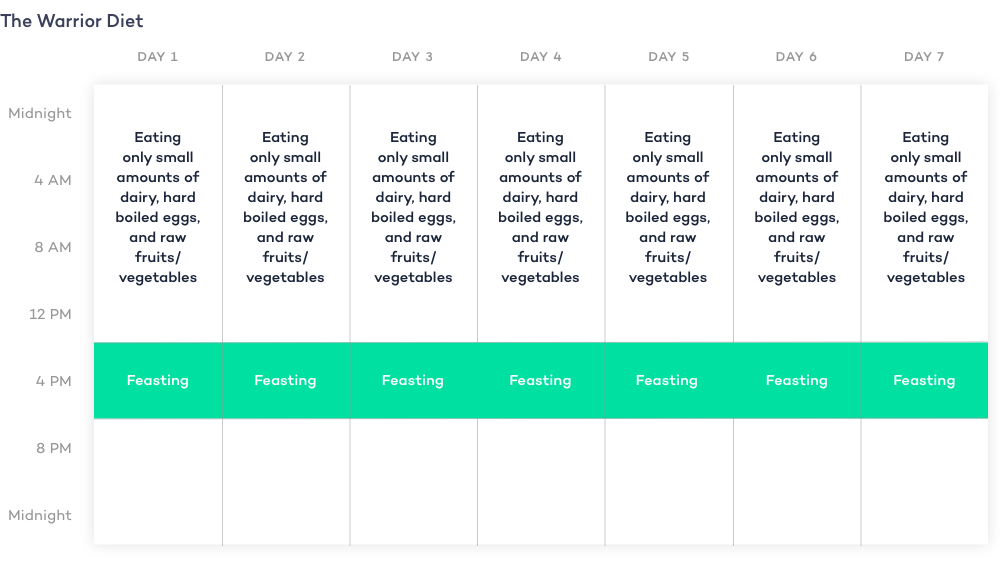
Restrict calories from 6 p.m. to 2 p.m. the next day. From 2 p.m. to 6 p.m. eat as much as you want.
Things to Note
Healthy and unprocessed food choices are not a good choice during the “binge” period.
5:2 Diet
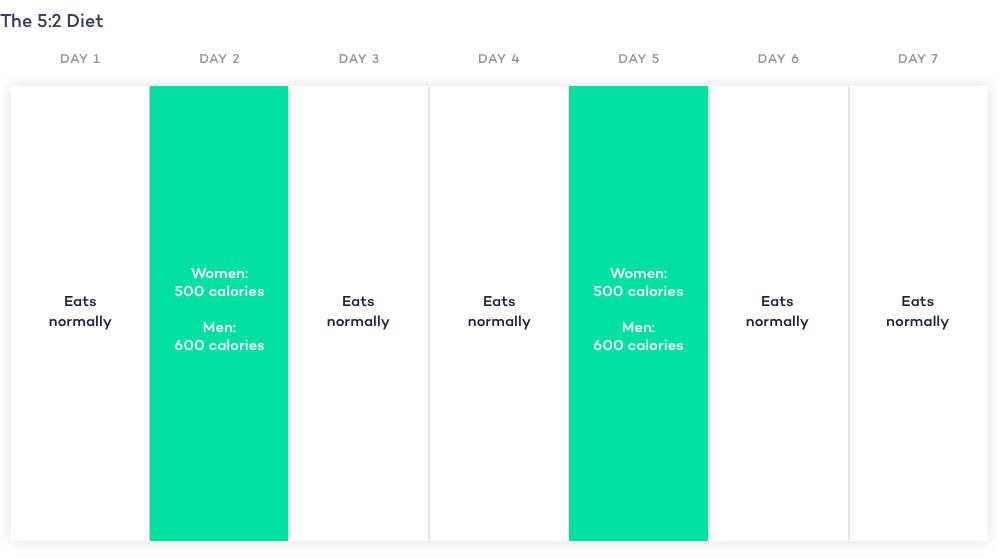
Here is another simple plan that many people find easier than following a conventional calorie-restricted diet. There are a few more rules to the 5:2 plan (also known as the Fast Diet) than other methods. Most people who follow this plan say it becomes more of a lifestyle after you get into a routine that works for you.
The Rules
Eat normally for five days a week, then restrict calorie intake for two days a week. On those two days consume only between 500-600 (some sources say 800) calories. You can pick any two days of the week you want, but make sure there is at least one non-fasting day between the two fasting days.
Example
A typical eating schedule looks like this: Fast/restrict calories on Tuesday and Friday and eat normally the other days of the week. On a fast day eat light low calorie foods. Boiled eggs and small amounts of dairy are all choices that could be included.
Things to note
Overall you should eat the same amount of food you would have consumed if you hadn’t been fasting at all. When enjoying a “normal” eating day remember by normal we don’t mean junk food. Healthy, non processed (and preferably ketogenic) choices are encouraged.
Circadian Rhythm Fasting
Circadian rhythm fasting is a time-restricted fasting plan that synchs the times you eat with the your circadian rhythm- or internal body clock.
The Rules
This fasting method involves eating during the daylight hours when your digestion and metabolism are most active. It also entails fasting after 7 pm when these internal systems slow down.
Example
A day in the life of a typical circadian rhythm fast may start with eating a nutrient-dense breakfast just after waking up–ideally, around 7 am. You will eat your last meal by 7 pm.
Typically, the last meal of the day is much lighter. A light dinner reduces blood sugar spikes and weight gain that can occur when your insulin response and metabolism wind down. The fast then continues through the night until breakfast the next morning.
Eat Stop Eat
This method involves one to two fast days per week. No food for 24 hours at a time is the goal. (20 hours is also a common time window for this method.)
The Rules
Eat around 2000 calories each day until the next fast day. When it’s time for a fast day, stop eating for 24 (or 20) hours and resume eating again on the 24 (20) hour mark. Don’t fast two days in a row.
Example
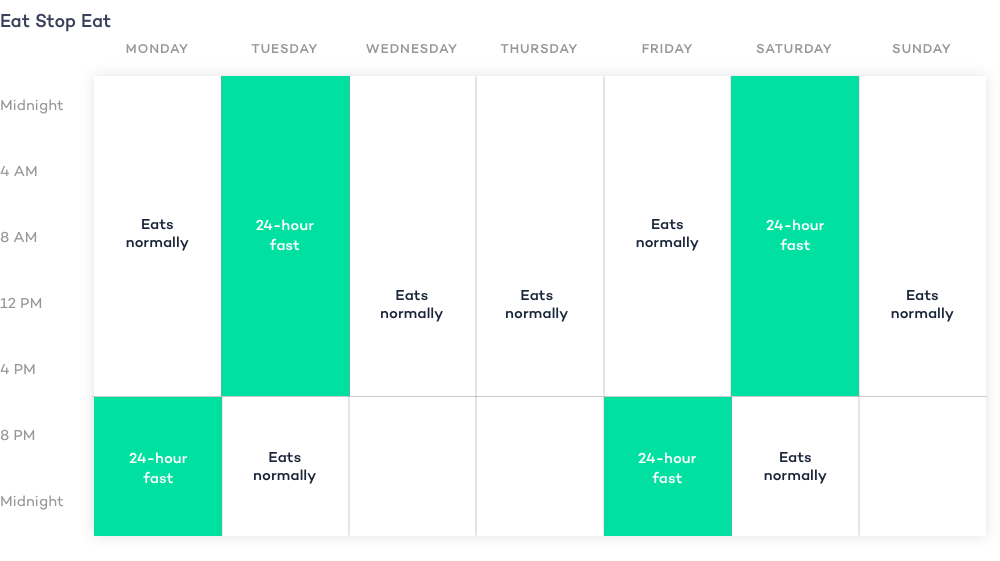
An eating schedule following these rules could look like this: Fast from 6 p.m. on Monday to 6 p.m. on Tuesday and 6 p.m on Friday to 6 p.m. on Saturday. Eat responsibly but normally at all other times.
Alternate Day Fasting
Alternate Day Fasting is one of the more studied/proven methods of intermittent fasting.
Numerous studies have shown this method to be effective and sustainable .
Some people find this method easier to stick to than other intermittent fasting methods or traditional diets. Another study has shown this diet seems to be effective whether you follow a low fat or high fat approach.
The Rules
The simple explanation of this method is fast every other day. Eat “whatever” you want on the non-fasting days. On fasting days you are allowed to have unlimited water, unsweetened coffee, and tea.
Example
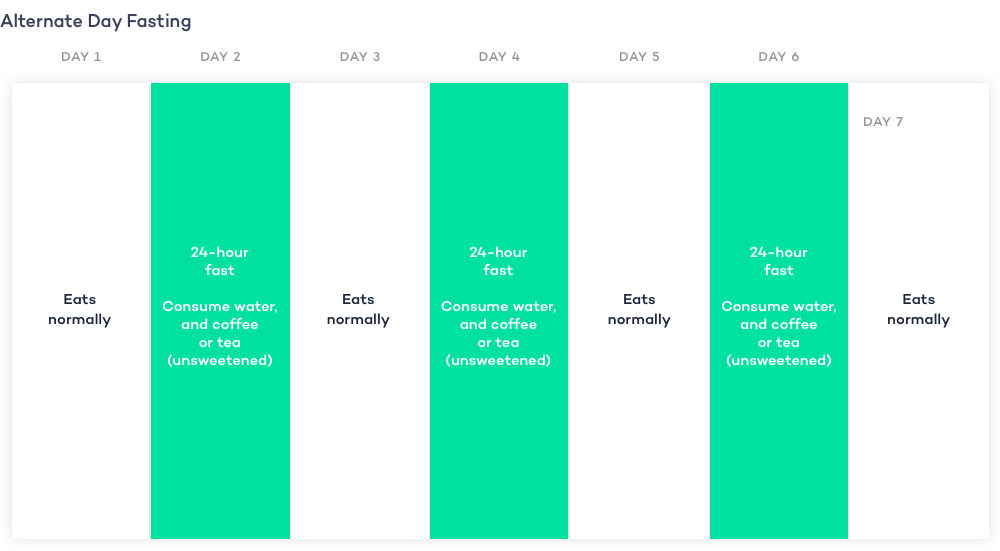
On Monday you eat as you wish, on Tuesday you only consume water, and coffee or tea (unsweetened). Wednesday you’re back to eating, Thursday fast, Friday eat etc.
Things to Note
An alternate approach to this method allows for up to 500 calories on fasting days and the benefits seem to be the same with this modification as without .
36 hour fast
This method is simple, but even more extreme. The 36 hour fast wouldn’t be a good starting point for beginners. This time frame marks the beginning of more prolonged or extended intermittent fasting
The Rules
Fasting is done for the entire day (and then some) generally totaling about 36 hours
Thankfully, much of that time is during sleeping hours.
Example
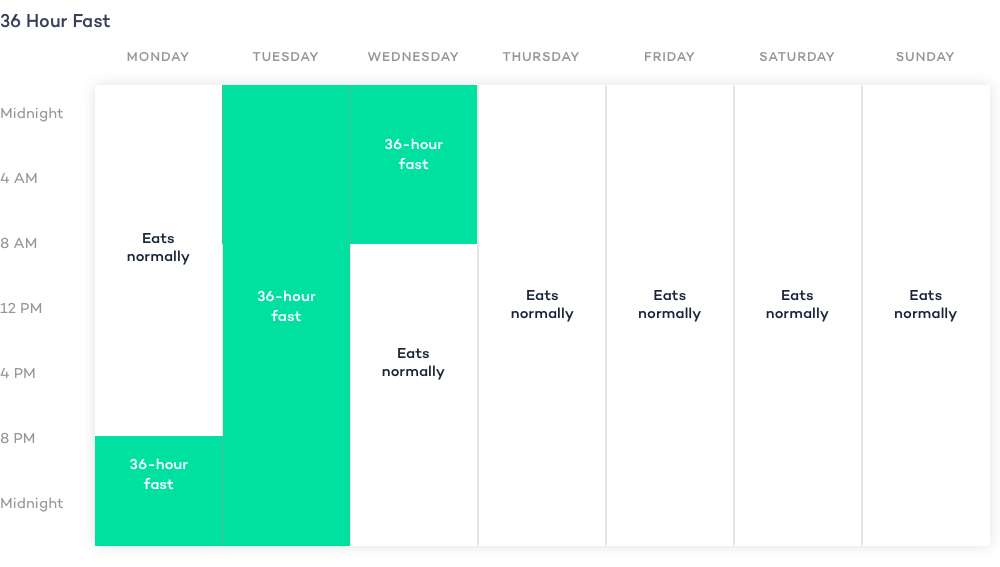
A typical 36 hour fast might go like this: Stop eating at 8p.m. on Saturday and don’t eat again until breakfast at 8 a.m. on Monday.
Things to Note
According to Dr. Jason Feung this method is often used for Type 2 diabetics in his clinic because it lowers blood sugar. Since Type 2 diabetics have more insulin resistance this length of time produces quicker results for that group of people.11
This is something to be mindful of, as low blood sugar can cause dizziness, headaches, and other side effects.
Longer Fasts
Fasting can be safely extended to much longer periods of time than 36-hours. These long fasts have their place in promoting your health. Longer fasts go up to 42 hours and beyond. The world record for fasting is 382 days . While remarkable, long fasts are generally not recommended by healthcare providers.
One of the major health benefits of these extended fasts, and a primary reason for attempting such a fast is the promotion of autophagy . Autophagy is the way your body removes damaged cells allowing for new cell growth. Autophagy and new cell growth stimulates healing and contributes to a healthier body, inside and out.
The Rules
CHECK WITH YOUR DOCTOR FIRST. This is the most important rule to ensure you aren’t at risk of complications. Generally, this is a water only fast between 42 hours and 14 days.
Things to note
Hydration and electrolytes are essential for any fast, but especially extended fasts.
Don’t push yourself too far. Be cautious when breaking your fast. Ease yourself back into consuming food, and don’t over eat.
The Bottom Line
Intermittent fasting (or as we like to say, feasting) is a proven method for maintaining a healthy lifestyle. Humans have been fasting since mankind began. We have evolved to go for long periods without eating. Maybe it’s worth it to go back to our roots when it comes to our eating habits.
As we have discussed, there are many ways of approaching this eating lifestyle. Now that you’ve learned about all the different ways you can intermittently fast, what are you waiting for? Get out there and stop eating . . . for a little!





















